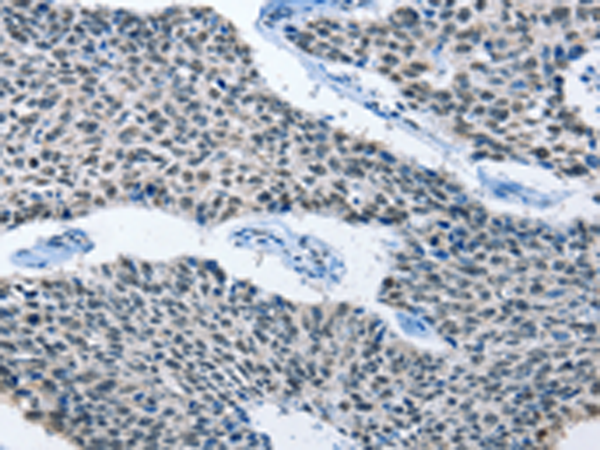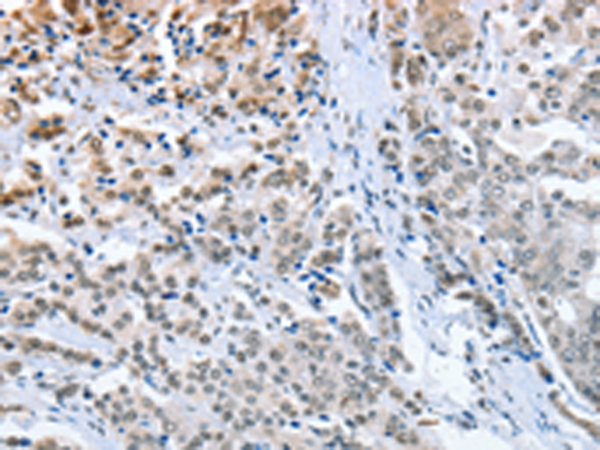


| WB | 1/500-1/2000 | Human,Mouse,Rat |
| IF | 咨询技术 | Human,Mouse,Rat |
| IHC | 1/25-1/100 | Human,Mouse,Rat |
| ICC | 技术咨询 | Human,Mouse,Rat |
| FCM | 咨询技术 | Human,Mouse,Rat |
| Elisa | 1/2000-1/5000 | Human,Mouse,Rat |
| Aliases | HUR; Hua; MelG; ELAV1 |
| WB Predicted band size | 36 kDa |
| Host/Isotype | Rabbit IgG |
| Antibody Type | Primary antibody |
| Storage | Store at 4°C short term. Aliquot and store at -20°C long term. Avoid freeze/thaw cycles. |
| Species Reactivity | Human, Mouse |
| Immunogen | Fusion protein of human ELAVL1 |
| Formulation | Purified antibody in PBS with 0.05% sodium azide and 50% glycerol. |
+ +
以下是关于ELAVL1抗体的3篇参考文献及其摘要概括:
1. **"ELAVL1 modulates transcriptome-wide miRNA binding in murine macrophages"**
- **作者**: Srikantan S, Gorospe M.
- **摘要**: 研究利用ELAVL1特异性抗体进行RNA免疫沉淀(RIP)实验,揭示了ELAVL1在巨噬细胞炎症反应中通过结合miRNA调控靶基因表达的机制。
2. **"HuR/ELAVL1 drives malignant peripheral nerve sheath tumor growth and metastasis"**
- **作者**: Zhou Y, et al.
- **摘要**: 通过免疫组化(IHC)和Western blot分析ELAVL1蛋白表达,证明其在恶性外周神经鞘瘤(MPNST)中高表达,并通过调控促癌基因促进肿瘤侵袭和转移。
3. **"Posttranscriptional regulation of cancer traits by HuR"**
- **作者**: Abdelmohsen K, Gorospe M.
- **摘要**: 综述ELAVL1(HuR)在癌症中的功能,重点讨论其抗体在检测亚细胞定位及与靶mRNA结合中的应用,强调其在肿瘤发生和治疗中的潜在价值。
以上研究均依赖ELAVL1抗体进行蛋白表达分析,涵盖炎症、肿瘤机制及临床转化方向。
The ELAVL1 (Embryonic Lethal, Abnormal Vision, Drosophila-like 1) protein, also known as HuR, is a member of the ELAVL/Hu family of RNA-binding proteins. It plays a critical role in post-transcriptional gene regulation by stabilizing and enhancing the translation of target mRNAs, particularly those containing AU-rich elements (AREs) in their 3' untranslated regions. ELAVL1 is involved in diverse cellular processes, including proliferation, differentiation, inflammation, and stress response. Its dysregulation is implicated in cancer, neurodegeneration, and autoimmune diseases, with elevated expression observed in many malignancies, correlating with poor prognosis.
ELAVL1 antibodies are widely used in research to detect and quantify the protein’s expression, localization, and interactions. These antibodies enable techniques such as Western blotting, immunohistochemistry, and immunoprecipitation, aiding studies on ELAVL1’s cytoplasmic-nuclear shuttling and regulatory mechanisms. Commercial ELAVL1 antibodies are typically raised against epitopes in its RNA-recognition motifs (RRMs) or linker regions. However, variability in specificity and cross-reactivity with other ELAVL family members (e.g., HuB, HuC, HuD) necessitates careful validation via knockout controls or siRNA-based approaches. Research applications span cancer biology (e.g., glioblastoma, colon cancer), neurobiology, and drug development, particularly in targeting ELAVL1-mediated pathways for therapeutic intervention.
×